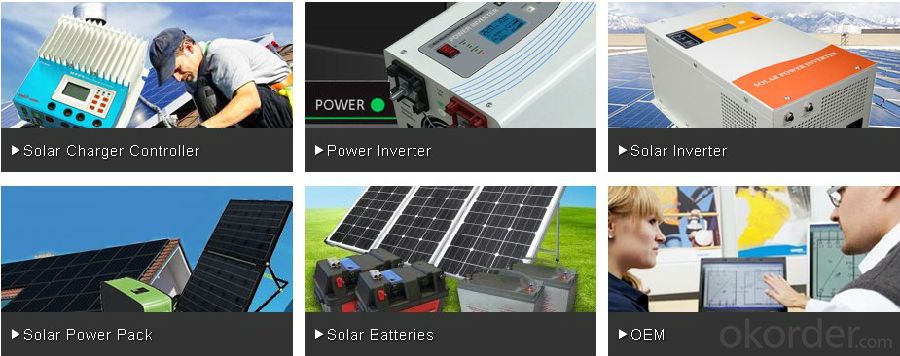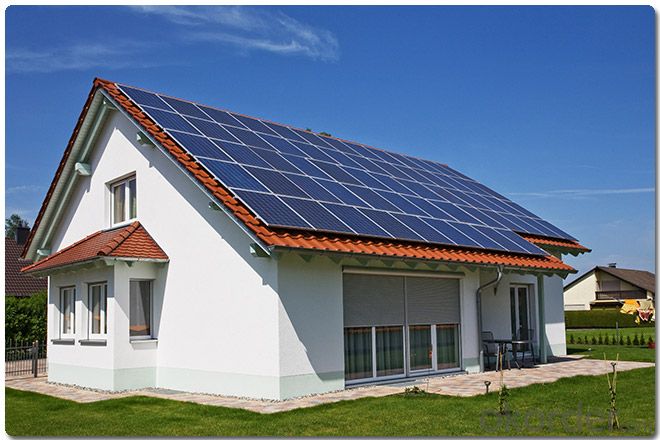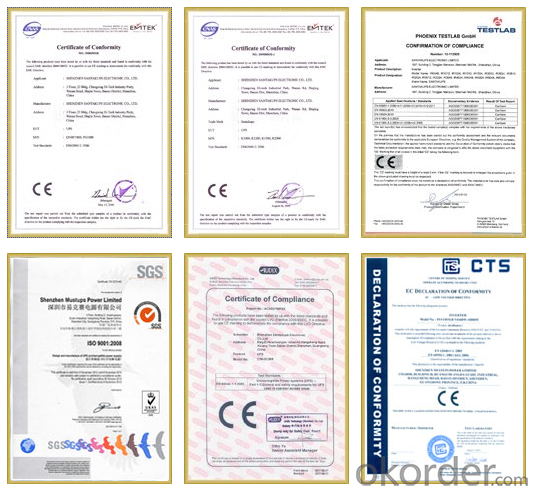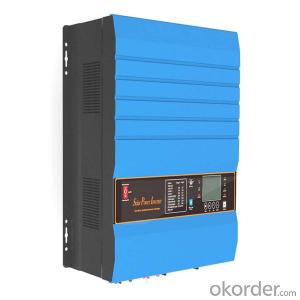10KW Pure Sine Wave Inverter New Function PV3500 Series 48V
- Loading Port:
- China main port
- Payment Terms:
- TT or LC
- Min Order Qty:
- 50 pc
- Supply Capability:
- 10000 pc/month
OKorder Service Pledge
OKorder Financial Service
You Might Also Like
Advances of Solar Inverter 10KW Pure Sine Wave Inverter New Function PV3500 Series 48V
Our solar inverters typically transfer to battery power in less than 16 milliseconds (less than 1/50th of a second).
Our solar backup electric systems use special high-quality electric storage batteries.
Main Features of Solar Inverter 10KW Pure Sine Wave Inverter New Function PV3500 Series 48V
.Power range 1kw-112kw
.12/24v/48v input optional
.Powerful Charge Rate Up to 100Amp
.Inbuilt pure copper transformer
.Pure sine wave output
.LED+LCD display
.MPPT solar charge controller 40A 45A 60A
.50/60HZ automatic sensing
.RS232 with free CD
.Battery priority function
.DC Start & Automatic Self-Diagnostic Function
.High Efficiency Design & “Power Saving Mode” to Conserve Energy
Specificationsc of Solar Inverter 10KW Pure Sine Wave Inverter New Function PV3500 Series 48V
Solar Inverter Model | 1.0KW | 1.5KW | 2.0KW | 3.0KW | 4.0KW | 5.0KW | 6.0KW | 8.0KW | 10.0KW | 12.0KW | |
Inverter output | Continuous output power | 1.0KW | 1.5KW | 2.0KW | 3.0KW | 4.0KW | 5.0KW | 6.0KW | 8.0KW | 10.0KW | 12.0KW |
Surge rating (20ms) | 3.0KW | 4.5KW | 6.0KW | 9.0KW | 12.0KW | 15.0KW | 18.0KW | 24.0KW | 30.0KW | 36.0KW | |
Output waveform | Pure sine wave/ same as input (bypass mode) | ||||||||||
Nominal efficiency | >88% (peak) | ||||||||||
Line mode efficiency | >95% | ||||||||||
Power factor | 0.9-1.0 | ||||||||||
Nominal output voltage RMS | 100-110-120VAC/220-230-240VAC | ||||||||||
Output voltage regulation | ±10% RMS | ||||||||||
Output frequency | 50Hz ± 0.3Hz / 60Hz ± 0.3Hz | ||||||||||
Short circuit protection | Yes (1sec after fault) | ||||||||||
Typical transfer time | 10ms (max) | ||||||||||
THD | < 10% | ||||||||||
DC input | Nominal input voltage | 12.0VDC / 24.0VDC / 48.0VDC | 24.0VDC /48.0VDC | 48.0VDC | |||||||
Minimum start voltage | 10.0VDC /10.5VDC for12VDC mode | *2 for 24VDC, *4 for 48VDC | |||||||||
Low battery alarm | 10.5VDC /11.0VDC for12VDC mode | ||||||||||
Low battery trip | 10.0VDC /10.5VDC for12VDC mode | ||||||||||
High voltage alarm | 16.0VDC for12VDC mode | ||||||||||
Low battery voltage recover | 15.5VDC for12VDC mode | ||||||||||
Idle consumption-search mode | <25W when power saver on. (refer to table) | ||||||||||
Charger | Output voltage | Depends on battery type (refer to table 2.5.2) | |||||||||
Charger breaker rating | 10A | 15A | 20A | 20A | 20A | 30A | 30A | 40A | 40A | 40A | |
Max charge power rate | 1/3 Rating power (refer to table 2.5.3) | ||||||||||
Battery initial voltage for start | 10-15.7VDC for 12VDC mode | *2 for 24VDC, *4 for 48VDC | |||||||||
Over charge protection S.D. | 15.7VDC for 12VDC mode | ||||||||||
BTS | Battery temperature sensor (optional) | Yes (refer to the table) Variances in charging voltage & S.D. voltage base on the battery temperature. | |||||||||
Bypass & protection | Input voltage waveform | Sine wave (grid or generator) | |||||||||
Nominal voltage | 110VAC | 120VAC | 220VAC | 230VAC | 230VAC | ||||||
Max input AC voltage | 150VAC for 120VAC LV mode; 300VAC for 230VAC HV mode. | ||||||||||
Nominal input frequency | 50Hz or 60Hz | ||||||||||
Low freq trip | 47 ± 0.3Hz for 50Hz; 57 ± 0.3Hz for 60Hz | ||||||||||
High freq trip | 55 ± 0.3Hz for 50Hz; 65 ± 0.3Hz for 60Hz | ||||||||||
Overload protection (SMPS load) | Circuit breaker | ||||||||||
Output short circuit protection | Circuit breaker | ||||||||||
Bypass breaker rating | 10 | 15 | 20 | 30 | 40 | 40 | 40 | 50 | 63 | 63 | |
Transfer switch rating | 30Amp for UL & TUV | 40Amp for UL | 80Amp for UL | ||||||||
Bypass without battery connected | Yes (optional) | ||||||||||
Max bypass current | 30Amp | 40Amp | 80Amp | ||||||||
Solar charger | Rated voltage | 12.0VDC / 24.0VDC / 48.0VDC | |||||||||
Solar input voltage range | 15-30VDC / 30-55VDC / 55-100VDC | ||||||||||
Rated charge current | 40-60A | ||||||||||
Rated output current | 15A | ||||||||||
Self consumption | <10mA | ||||||||||
Bulk charge (default) | 14.5VDC for12VDC mode | *2 for 24VDC, *4 for 48VDC | |||||||||
Floating charge (default) | 13.5VDC for12VDC mode | ||||||||||
Equalization charge (default) | 14.0VDC for12VDC mode | ||||||||||
Over charge disconnection | 14.8VDC for12VDC mode | ||||||||||
Over charge recovery | 13.6VDC for12VDC mode | ||||||||||
Over discharge disconnection | 10.8VDC for12VDC mode | ||||||||||
Over discharge reconnection | 12.3VDC for12VDC mode | ||||||||||
Temperature compensation | -13.2mVDC/℃ for12VDC mode | ||||||||||
Ambient temperature | 0-40℃ (full load) 40-60℃ (derating) | ||||||||||
Mechanical specifications | Mounting | Wall mount | |||||||||
Inverter dimensions (L*W*H) | 388*415*200mm | 488*415*200mm | 588*415*200mm | ||||||||
Inverter weight (solar chg) KG | 21+2.5 | 22+2.5 | 23+2.5 | 27+2.5 | 38+2.5 | 48+2.5 | 49+2.5 | 60+2.5 | 66+2.5 | 70+2.5 | |
Shipping dimensions (L*W*H) | 550*520*310mm | 650*520*310mm | 750+520+310mm | ||||||||
Shipping weight (solar chg) KG | 23+2.5 | 24+2.5 | 25+2.5 | 29+2.5 | 40+2.5 | 50+2.5 | 51+2.5 | 62+2.5 | 68+2.5 | 72+2.5 | |
Display | LED+LCD | ||||||||||
Standard warranty | 1 year | ||||||||||
Pictures of Solar Inverter 10KW Pure Sine Wave Inverter New Function PV3500 Series 48V

Solar Inverter's Application

Warranty of Solar Inverter 10KW Pure Sine Wave Inverter New Function PV3500 Series 48V
OKorder’s Products provides a 1~3 year limited warranty (“Warranty”) against defects in materials and workmanship for its Uninterruptible power supply, Power inverter/chargers, Solar charge controllers, Battery Products (“Product”).
The term of this Warranty begins on the Product(s) initial purchase date, or the date of receipt of the Product(s) by the end user, whichever is later.
This must be indicated on the invoice, bill of sale, and/or warranty registration card submitted to MUST-Solar.
This Warranty applies to the original MUST-Solar Product purchaser, and is transferable only if the Product remains installed in the original use location.
Certificates of Solar Inverter 10KW Pure Sine Wave Inverter New Function PV3500 Series 48V

FAQ of Solar Inverter 10KW Pure Sine Wave Inverter New Function PV3500 Series 48V
How to guarantee the quality of the products?
We have established the international advanced quality management system,every link from raw material to final product we have strict quality test;
We resolutely put an end to unqualified products flowing into the market.
At the same time, we will provide necessary follow-up service assurance.
How long can we receive the product after purchase?
In the purchase of product within three working days, We will arrange the factory delivery as soon as possible.
- Q:Can a solar inverter be used with a solar-powered air cooling system?
- Yes, a solar inverter can be used with a solar-powered air cooling system. The solar inverter would convert the direct current (DC) electricity produced by the solar panels into alternating current (AC) electricity, which can then be used to power the air cooling system. This allows the system to operate efficiently and effectively using solar energy.
- Q:What is the maximum AC output power of a solar inverter?
- The maximum AC output power of a solar inverter is determined by its capacity and specifications, but it typically ranges from a few hundred watts to several kilowatts.
- Q:What is the role of a solar inverter in protecting the electrical grid?
- The role of a solar inverter in protecting the electrical grid is to ensure the safe and efficient integration of solar power into the grid. It converts the direct current (DC) produced by solar panels into alternating current (AC) that is compatible with the grid. Additionally, solar inverters monitor and regulate the flow of electricity, providing grid stability by managing voltage and frequency fluctuations. They also incorporate safety mechanisms to disconnect from the grid in case of emergencies or grid disturbances, protecting both the solar system and the overall electrical grid.
- Q:Can a solar inverter be used with a solar-powered CCTV system?
- Yes, a solar inverter can be used with a solar-powered CCTV system. A solar inverter is responsible for converting the direct current (DC) produced by solar panels into alternating current (AC) that is used to power electrical devices. In the case of a solar-powered CCTV system, the solar panels generate DC electricity, which is then fed into the solar inverter to convert it into AC power, enabling it to operate the CCTV cameras and other necessary equipment.
- Q:Can a solar inverter be used with a solar-powered street lighting system?
- Yes, a solar inverter can be used with a solar-powered street lighting system. A solar inverter is responsible for converting the direct current (DC) produced by solar panels into alternating current (AC) that can be used to power electrical devices. In the case of a solar-powered street lighting system, the solar inverter can convert the DC power generated by the solar panels into AC power to operate the street lights. This allows the system to efficiently utilize the energy generated by the sun and provide reliable lighting for the streets.
- Q:Is the grid side of the grid and the inverter?
- The grid load side of the grid is the grid. The inverter is an important part of the PV grid-connected system and can not be regarded as an external load. Photovoltaic power generation system is included in both grid and off-grid.
- Q:Are there any safety risks associated with solar inverters?
- Yes, there are potential safety risks associated with solar inverters. These risks can include electrical hazards, such as electric shock or fire, especially if the inverter is not installed or maintained correctly. Additionally, there is a possibility of arc flash incidents and potential exposure to high voltage DC electricity. It is important to follow proper installation and maintenance procedures, as well as adhere to safety guidelines provided by manufacturers and professionals, to mitigate these risks and ensure safe operation of solar inverters.
- Q:What is the maximum DC input voltage for a solar inverter?
- The maximum DC input voltage for a solar inverter typically depends on the specific model and manufacturer. However, in general, most solar inverters have a maximum DC input voltage ranging from 600 to 1000 volts.
- Q:What are the common maintenance requirements for a solar inverter?
- Some common maintenance requirements for a solar inverter include regular cleaning to remove dust and debris, checking for loose connections or wiring issues, monitoring performance and output levels, and ensuring proper ventilation to prevent overheating. It is also important to keep an eye on the inverter's display for error messages or any signs of malfunctioning. Regular inspections and maintenance by a qualified technician are recommended to ensure optimal performance and longevity of the solar inverter.
- Q:Can a solar inverter be used in areas with high altitude and low temperature conditions?
- Yes, a solar inverter can be used in areas with high altitude and low temperature conditions. However, it is important to choose a solar inverter specifically designed for such conditions, as extreme cold temperatures and high altitudes can affect the performance and efficiency of standard inverters. Specialized inverters that can withstand low temperatures and operate at high altitudes are available in the market to ensure optimal functioning of solar power systems in such environments.
1. Manufacturer Overview |
|
|---|---|
| Location | |
| Year Established | |
| Annual Output Value | |
| Main Markets | |
| Company Certifications | |
2. Manufacturer Certificates |
|
|---|---|
| a) Certification Name | |
| Range | |
| Reference | |
| Validity Period | |
3. Manufacturer Capability |
|
|---|---|
| a)Trade Capacity | |
| Nearest Port | |
| Export Percentage | |
| No.of Employees in Trade Department | |
| Language Spoken: | |
| b)Factory Information | |
| Factory Size: | |
| No. of Production Lines | |
| Contract Manufacturing | |
| Product Price Range | |
Send your message to us
10KW Pure Sine Wave Inverter New Function PV3500 Series 48V
- Loading Port:
- China main port
- Payment Terms:
- TT or LC
- Min Order Qty:
- 50 pc
- Supply Capability:
- 10000 pc/month
OKorder Service Pledge
OKorder Financial Service
Similar products
New products
Hot products
Related keywords






























